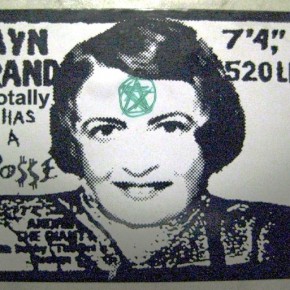Umskiptar (“Metamorphosis,” in old Norse) is Kristian “Varg” Vikerenes’ third album since his 2009 discharge from prison. Incarcerated for the murder of former bandmate Oystein Aarseth, and arson attacks on several churches, the one-man black band (otherwise known as Burzum) remains a lightning rod for controversy.
Discussions of Burzum are often nuanced affairs (true believers aside.) First there’s the genre-defining music. Then there are Vikernes’ increasingly extreme political views. This record is no different.
Through it all, Burzum.org, once a labor of love (or hate as the case may be) of a Russian fan, has served as the clearinghouse for the man and the band. Ralph Waldo Emerson famously opined, “A foolish consistency is the hobgoblin of little minds.” Burzum.org makes clear that consistency is not one of Vikernes’s myriad preoccupations.
Two days after Anders Breivik murdered 77 of his fellow Norwegians in July of 2011, Vikernes published a missive entitled, War in Europe: Part I – Cui bono? on Burzum.org. His haphazard analysis hinges upon bizarre associations and improbable allegations including:
- Breivik was working for Mossad in a “false flag” operation designed to punish Norway for supporting Palestine and to unite Norwegian ultra-nationalists under a false banner.
- Breivik is a Freemason and all Freemasons are puppets for “international Jewry.” Therefore, Breivik was working for the Jews to dismantle all nations in order to build a global Hebrew temple enslaving all under the will of the Jews and their servants the Freemasons.
- Breivik is a Christian and Christianity was created by Jews in order to dupe non-Jews into worshiping the Hebrew’s god which, in turn, would turn European pagans into servants and tools for the Jews.
The “facts” Vikernes puts forth resemble the loose associations of a schizophrenic. This embarrassing essay begins and ends with his tired fixation on a Jewish plot for world domination. He never connects the dots. Then again, that was never his intention. He ends his essay informing Breivik that, “True nationalists don’t kill children of their own nation.” The reader may comfortably infer non-native children remain fair game.
Vikernes returns to the topic of Breivik nine months later. In the interim, he utilized Burzum.org to publish, among other items, a pair of exhortations to his fans and fellow nationalists.
The first piece, The Lords of Lies: Part X – Thieves and Frauds , is a fairly transparent overture to his fans to help secure his economic interests (sorry, artistic interests) by boycotting and reporting all sites not named Burzum.org. Vikernes describes his boycott of social media as a conscious attempt to starve the capitalists and bankers who are destroying Europe. One wonders who he might mean? In either regard, his assertion is particularly humorous as Vikernes spends a chunk of the preceding text discussing his limited computer skills and experience.
The Lord of Lies: Part XI: Under Friendly Fire , the second essay, laments his rough treatment at the hands of leftwing journalists. Vikernes references his previous attempts to use media, in the form of interviews, to spread dissident ideas. The thrust of the essay is a plea for fellow nationalists to avoid using the media to draw negative conclusions about Vikernes. He returns to an old chestnut when he concludes only the Jews profit when nationalists fight with one another. Of particular interest is his discussion of the Protocols of the Elders of Zion.
Vikernes asserts that Jews have a vested interest in destroying Russia because Russians are responsible for releasing The Protocols to the world and painting the Jews in a negative light. Readers unfamiliar with the book should congratulate themselves. The Protocols of the Elders of Zion is a fictitious account of a meeting between Jewish elders in a European cemetery during which they outline their plot to take over the world. Vikernes addresses the dubious authenticity of the book in the essay’s third footnote where he asserts, bizarrely, that whether or not the text is a fraud or authentic is immaterial. The material issue is the content, which he feels is genuine, and should be read by everyone. He offers no support for the validity of the text itself or the content, but then again, why would he? He is consistently inconsistent in supporting his anti-Semitic worldview.
As to Breivik, Vikernes revisits him in a July 21, 2012 essay entitled, War in Europe: Part II – The Price of Anti-Racism . The essay is an attack on Grethe Bøe-Waal and her article, “The Price of Racism.” His typical meandering analysis features an analogy of a dog being placed among wolves. Vikernes states that a dog placed among wolves will be destroyed by the wolves who recognize it as different. He concludes this is the law of nature and expounds upon the analogy by stating that, when the number of dogs increase, they will begin to kill the wolves (Leaving aside the obvious flaws in this argument, such as the numerous examples of symbiosis in nature.) When Vikernes finally discusses Breivik, it is telling. Gone is the Christian, Freemason dupe discrediting Norwegian nationalists and serving the ends of international Jews. Instead, he is described thus:
Try to corner an animal and you will see what will happen! Be not surprised when the animal attacks you. Humans are also animals, and people like Anders Breivik act on instinct because you have cornered them. You can actually thank yourselves for the fact that he killed some of you “anti-racists.” You have cornered our entire European race! Like Breivik says, more and more individuals in the European nations will react with aggression.
In nine months, Vikernes’ Jewish puppet has transformed into Norway’s avenging angel. Unmolested by hobgoblins, he is free to draw increasingly improbable conclusions to support his deranged worldview. He is a dark Don Quixote tilting against windmills of his own making.
What then of Umskiptar, Vikernes’ interpretation of the poetic Edda Voluspo? The album begins well enough with “Blóðstokkinn” featuring sparse drums and sparing use of a horn while Varg solemnly intones portions of the opening stanzas. The introductory track is superior to those on both Belus and Fallen and serves to effectively set the album’s mood.
Tracks like “Jo’ln” and “Aera” are reminiscent of Fallen with their diminished, but still present, tremolo picking and lyrics both spoken and sung. “Alfadanz” makes effective use of a piano intro that gives way to some repetitive guitar work and interplay between both sung and spoken vocals. “Hit Helga Tre’“most resembles the classic Burzum sound augmented by some pretty sweet riffage.
Vikernes continues to use a warmer (compared to say Filosofem) vocal style throughout Umskiptar. When accompanied with chanted or spoken vocal parts, it comes off very well. However, the later portion of the album is comprised of songs that rely heavily on speaking or chanting coupled with strummed guitar lines. These tracks seem to be an attempt to create something of a somber, ethereal sound. This is where cracks begin to surface.
“Valgaldr” works reasonably well, tremolo guitar work and harsh vocals eventually giving way to a slowing of tempo, a repeated riff and drone-like vocals. However, tracks like “Galgviör” and “Surtr Sunnan” simply meander. Both pieces build upon simple guitar parts coupled with spoken or droned vocals. Where bands like Agalloch or Drudkh can take that formula and make it effective due their more robust instrumentation, here the songs just sound flat and unfinished.
Umskiptar ends limply, with “Gullaldr” succumbing to the same compositional malady, but with even less of a riff to rely on. “Níðhöggr” is simply a disaster of muted drumming, rasped vocals and the addition of what can only be described as whale sounds.
Burzum’s tenth full length begins with promise but fails to sustain the momentum. There are signs of an interesting evolution in “Allfadanz” and “Valgaldr.” Nonetheless, the missteps of the final four tracks really diminish the album. It remains to be seen which direction Vikernes will choose for future recordings. However, the maddening inconsistencies that characterize his personal life have certainly tainted Umskiptar.
This article first appeared in A Thousand Trivialities. Varg Vikernes photograph courtesy of Wikipedia. Published under a Creative Commons license.






Another (review) gets caught on the political views and does not focus on the music.